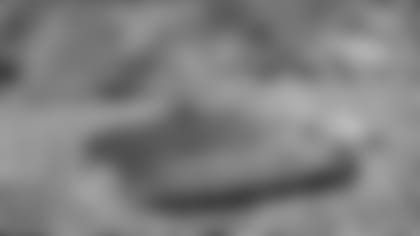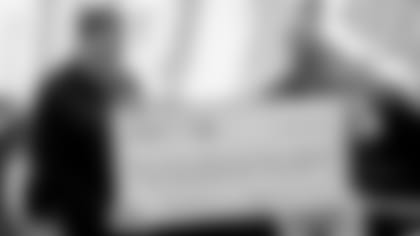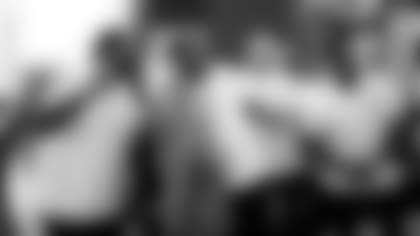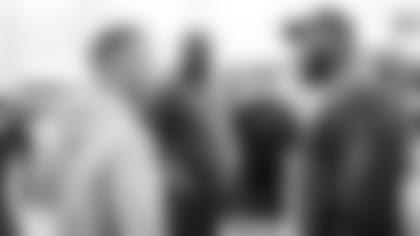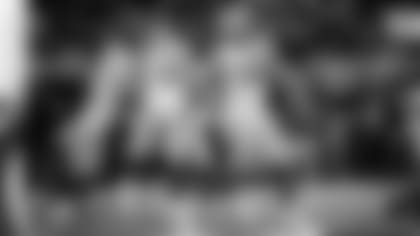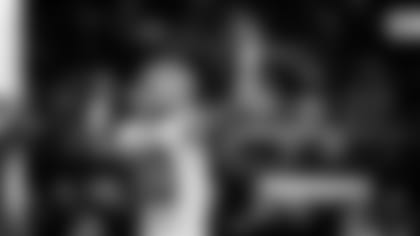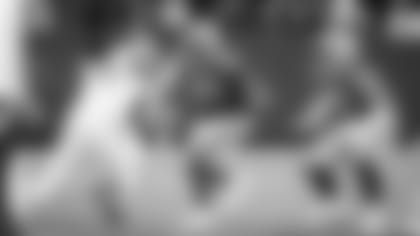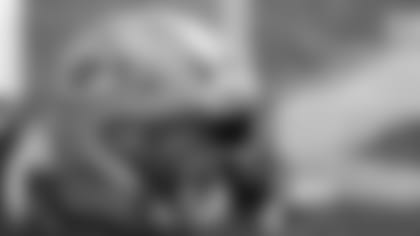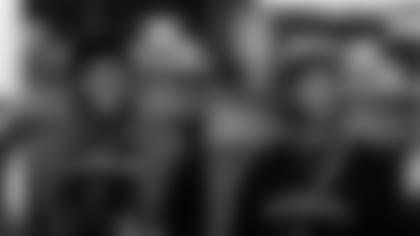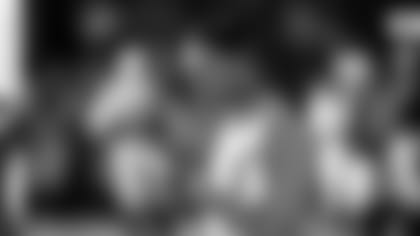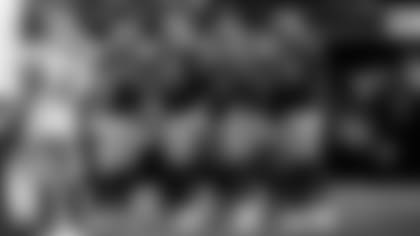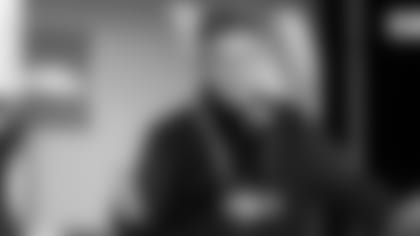For the second straight month, I'm going to stick to questions about Lambeau Field, or what was originally named Green Bay City Stadium.
Doug from Estherville, IA
How much of the original structure of Lambeau Field is remaining after all the various stages of remodeling and rebuilding over decades?
Ted Eisenreich, our director of facility operations, tells me only some of the concrete and structural steel.
The concrete would include the first 60 rows of the sideline seats, or what today would be sections 111 to 127 on the east side and sections 112 to 128 on the west side. In the end zone, it would basically include the first 21 rows of sections 129 to 138 at the south end and sections 101 to 110 at the north end. The structural steel supporting those aboveground sections of the sideline seats also remains intact.
*The original wooden benches were replaced by aluminum in 1969. The original chain-link fence with barbed wire at the top was replaced with a 16-foot high aluminum fence in 1970 when the stadium became a complete bowl. Even the concourses were widened at that point and again during the 2001-03 redevelopment. *
A recent Milwaukee Journal Sentinel story about the 1996 Packers stated that when they won the Super Bowl Lambeau "still was encircled by the corrugated steel fence dating to its construction in 1957." For the record, that was incorrect and an example of how Packers history gets distorted when writers don't verify what they present as facts.
Indeed, in the 1960s, the Press-Gazette used to run a reminder before games telling "all stadium workers, including gatemen, ushers, fence patrol and inside police," to report to the stadium well in advance of when the gates opened. The fence patrol watched for people trying to climb the chain-link fence to sneak in.
Gordon from Kirkcaldy, Scotland
In browsing old still pictures and video footage, the development of the stadium has been incredible. How and why did it develop as it did from its beginnings as new City Stadium with a capacity of 32,000-plus to the enclosure of the north end to form a bowl and capacity of 56,263?
Although NFL Commissioner Bert Bell said on Sept. 29, 1957, "the dedication of this stadium today is the greatest thing that has ever happened in professional football," it was, as you've noticed, a barebones 32,154-seat facility.
The Packers didn't even have their offices on site.
Obviously, ticket demand would be the best answer to the "why" part of your question. When the stadium opened in 1957, the Packers sold roughly 24,000 season tickets. In 1958, attendance for the last of the Packers' four Green Bay games during their 1-10-1 season was 28,051. Vince Lombardi arrived in 1959 and two years later, the Packers sold out their games in Green Bay on a season-ticket basis for the first time.
That leads to the "how" part of your question. There were two major stadium expansions during Lombardi's nine seasons as coach, increasing capacity to 38,669 in 1961 and to 50,852 in 1965. Approximately, 3,600 temporary bleacher seats were installed in 1963, upping capacity to 42,327, but those seats were removed during the 1965 expansion. In 1965, capacity was increased by only 8,365, but 12,053 permanent seats were added. In 1970, 5,411 seats were added to complete the bowl and bring capacity to 56,263.
John from Chicago
I have distinct memories of being able to take beer into games in the 1970s, as long as it was in cans. Am I dreaming or was that the case?
Rest assured, your memory is serving you well. Tom from Arlington, Va., said he also remembered bringing his own beer to games when he was a college student.
Lambeau was the last stadium in the NFL to ban carry-ins. In 1982, less than three weeks before the Packers' first preseason game, the Green Bay City Council passed an ordinance prohibiting fans from bringing can beer and coolers into the stadium. Sixteen years earlier, or five days before the 1966 opener, the City Council voted to prohibit fans from carrying bottled beer and soda into the stadium.
In fact, I remember a game against the Baltimore Colts in 1960 when fans threw beer cans and whiskey bottles onto the south end of the field after Jesse Whittenton was called for pass interference. Later, when the Colts left the field at the end of the game, a fan poured beer down Big Daddy Lipscomb's back. It was Lombardi's first victory over the two-time defending NFL champion Colts and he was ecstatic, calling it, "My greatest day in football." While he admonished fans for throwing things on the field, he also lauded them. "They helped us win," he said.
There was little uproar about the incident initially, but three days later Green Bay Mayor Roman Denissen asked the City Council to forbid fans from carrying in intoxicants. Aldermen refused. "Six-Pack Lobby Wins," the Press-Gazette headline read after the vote. Alderman Ed Vanark argued if fans weren't allowed to lug their own beer into the stadium, the Packers wouldn't be able to sell it out.
It took six years before the city banned bottles and 22 years before it banned cans.
Obviously, times were different.
NFL Commissioner Pete Rozelle was at the Baltimore game and, at least publicly, never made a fuss about the incident. In fact, when I went back and read the coverage in the next day's Baltimore Sun, the Colts seemed to be more upset with the bare and patched-up turf than the beer and bottle throwing. Sun sportswriter Edward Atwater noted in his story that high school teams had chewed up the field two weeks earlier.
Joe from Fond du Lac, WI
Your article about the criteria for judging the greatest quarterbacks was the best pro football article I ever read. I'm 72 years old, went to St. Norbert College and our fraternity sold beer at the stadium from 1961 to 1965. One wanted to get there in time to be able to sell Pabst, not Rahr's, for obvious reasons.
Thanks for the kind words and for reminding us that Pabst and Rahr's were the two beers sold when new City Stadium opened in 1957. Rahr's was founded in 1866 and the last survivor of the big four pre-Prohibition Green Bay breweries. I know people our age were too smug to drink Rahr's in the 1960s, but let's not forget its slogan: "It's The Best Beer In Any Case!"
Greg from Crystal Lake, IL
There was a lengthy period when the two west side high schools, West and Southwest, called Lambeau Field home. I had many friends who played there on Friday nights. Can you tell us how that tradition started and when it stopped?
This was a popular question. Randy from Green Bay, Jim from Madison and Mark from St. Pete Beach, Fla., essentially asked the same thing.
There were high school games played in the stadium from the start. In fact, before the stadium was built in 1957, one of the selling points was that it could also be used by the city's two public high schools at the time, West and East. The Press-Gazette ran a series before the 1956 bonding referendum about the need for a stadium and the headline on Part 1 was: "New Stadium Needed for High Schools as Well as Packers." There was even discussion about including a track so the high schools could hold meets at the new stadium.
In the end, West moved its football games to new City Stadium, but East continued to play its games at what had been old City Stadium. Additionally, East vs. West was the biggest high school game of the year in the Green Bay area at the time and it was played at new City Stadium from 1957 through 1963. Thereafter, from 1964 through 1978, the game switched back and forth between old City Stadium – or East Stadium as it had been renamed – and Lambeau Field.
Green Bay Southwest opened in the fall of 1964 and shared new City Stadium with West, but by then restrictions had been placed on when high school games could be played there. An even bigger problem for the schools was that games were being frequently moved to other sites on short notice when there was a threat of rain. Clearly, as the Packers' home games became more spread out and turf issues became a greater concern for players and club officials alike, the relationship between the Packers and the high schools became more strained.
In 1977, after two previous games played in the rain had chewed up the turf at Lambeau Field, everything came to a head when the final three high school games scheduled there were moved to another site. The Packers forced the issue because they feared the field wouldn't be ready for their Oct. 30 contest against the Chicago Bears. As a result, there were only two high school games played in Lambeau that year, one being the East-West game.
In 1978, West and Southwest had eight games scheduled at Lambeau, but they were all moved to other sites just days before the season started.
On Sept. 14, 1979, Del Marcelle Stadium, a 1,750-seat stadium built behind West High School, was dedicated, and Lambeau was no longer needed for high school football games.
Randy included a follow-up question about whether private schools used Lambeau for playoff games. The answer is yes. The first Wisconsin Independent Schools Athletic Association state championship was played there Nov. 15, 1969. The WISAA championship also was played there in 1971 and 1973.
Ron from Plymouth, MN
Our family has held season tickets since the early 1960s, I believe. Since we changed names on the account we're not sure when the tickets were purchased. Can you tell me when Section 133, Row 40 was added?
As you may know, the numbering system was changed with the 2001-03 renovation. Section 33 (now 133) Row 40 was added in 1961. When the stadium opened in 1957 there were only 21 rows in the end zones, 60 on the sidelines. In 1961, sections 29, 30, 31, 32, 33 and 34 – all in the southeast and southwest corners – were increased from 21 to 60 rows.
Hilmi from Ankara, Turkey
Has anyone ever died from the cold – or something else – watching a game at Lambeau Field?
I have heard of people dying from heart attacks suffered during games there. For example, in 1965, two people collapsed and died at the Minnesota Vikings game on Dec. 5, and two others died of heart attacks during the Western Conference playoff against the Baltimore Colts on Dec. 26. But the game-time temperature was 40 degrees for the Vikings game and 32 for the Colts game. I don't believe anyone died at the Ice Bowl and it doesn't get much colder than minus-46 wind chill.
Andrew from Los Angeles
My family's last name was Vannieuwenhoven and my grandfather owned farmland on Ridge Road where the Sentry grocery store used to be. I believe an uncle sold the farmland to the Packers where the stadium was built. Could you tell me why this area was chosen and what you know about the sale?
The site was recommended in July 1956 by the Osborn Engineering Co. of Cleveland, Ohio, after surveying close to 15 sites. Up to that point, the two proposed sites were behind Green Bay East High School, where old City Stadium stood, and Perkins Park on the northwest side of Green Bay. East siders preferred the old City Stadium site; West siders, Perkins Park.
Osborn determined it would be cheaper to build the stadium at what was then referred to as the Ridge Road-Highland Avenue location, partly because the site was elevated and the stadium could be built into the ground. A traffic analysis and available parking were two other considerations.
The tract covered roughly 53 acres and it was owned by Victor Vannieuwenhoven. The purchase plan approved by the Green Bay City Council included a cost of $1,500 per acre or a total of $79,500. Dominic Olejniczak, local realtor and member of the Packers executive committee, purchased 20 other acres for possible parking.
But Vannieuwenhoven kept a piece of land on the west side of the stadium for his residence. That wasn't purchased by the city until 1963. There are early aerial photos of the stadium that show the farmhouse in the stadium parking lot.
Dan from De Pere, WI
I recall reading that the two sites under consideration for new City Stadium was the site where it was built and Perkins Park. Is that true and what was the deciding factor in selecting the Ridge Road site?
As noted in my previous answer, the two sites under consideration were Perkins Park and where old City Stadium was located behind East High School, not where Lambeau now stands.
In fact, the old stadium site was the original frontrunner. In December 1954, as momentum was building for a new stadium, the Packers corporation submitted a three-page report to the Green Bay City Council suggesting new steel stands be built at old City Stadium, increasing capacity to more than 30,000. A month later, the City Council voted to hire an architect to prepare plans for an enlarged City Stadium behind East High.
The architect was hired in April 1955 and four months later, the Packers and the Board of Education approved the plans. The biggest debate was whether the new stadium should include a track. The Board of Education favored one; the Packers were on board with the overall plan, but preferred eliminating the track. Only West Side alderman Leonard Jahn voiced opposition to the old stadium site. He wanted the new stadium to be built at Military Avenue and Boland Road, or the Perkins Park site. In September 1955, Mayor Otto Rachals threw his support behind building the new stadium on the old City Stadium site.
But opponents, led by Jahn, continued to fight for the Perkins Park plan and the debate essentially evolved into an**East Side-West Side battle**that had to be decided by an outside firm.
Mark from Appleton, WI
You mentioned 1957 ticket prices and stated it cost $3.30 for a ticket in the south end zone and $2.25 in the north end zone. What accounted for the difference?
Sorry, but I don't know. Obviously, nobody could anticipate the drama that would subsequently take place at that end: Bart Starr's sneak, the first Lambeau Leap, etc. In 1957, the locker rooms were located in a small concrete block building on the open concourse in the south end. Thus, that was where the ramp to the playing field was located. Maybe the Packers thought fans would pay more to get a birds eye view of the players coming on and off the field.



